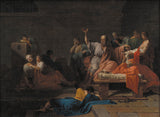Jean Francois Pierre Peyron, 1787 - The Death of Socrates - fine art print
Tax included. Shipping calculated at checkout.
This over 230 years old painting called "The Death of Socrates" was made by the painter Jean Francois Pierre Peyron in the year 1787. It is in the the Statens Museum for Kunst (National Gallery of Denmark)'s art collection in Copenhagen, Denmark. With courtesy of: National Gallery of Denmark (licensed - public domain).Furthermore, the work of art has the creditline: . Furthermore, alignment of the digital reproduction is landscape with a side ratio of 4 : 3, which means that the length is 33% longer than the width.
Pick your art print material option
For every product we offer a range of different materials and sizes. You can choose among the following product customization options:
- The poster print (canvas material): The poster is a UV printed sheet of flat canvas paper with a fine surface structure. Please keep in mind, that depending on the size of the poster print we add a white margin between 2-6 cm round about the artwork to facilitate the framing with your custom frame.
- Printed acrylic glass (with real glass coating): A glossy print on acrylic glass, often referred to as a plexiglass print, makes your chosen original into beautiful décor. Further, the acrylic art print is a good alternative to aluminium and canvas fine art prints. Our real glass coating protects your selected art replica against light and external influences for up to six decades.
- Aluminium print (aluminium dibond): An Aluminium Dibond print is a material with an outstanding effect of depth. For our Direct Aluminium Dibond option, we print your chosen work of art onto the surface of the aluminum composite. The bright & white sections of the original artpiece shine with a silk gloss, however without any glare.
- Canvas print: A canvas direct print is a printed canvas mounted on a wooden stretcher. The advantage of canvas prints is that they are relatively low in weight, which means that it is easy and straightforward to hang the Canvas print without extra wall-mounts. A canvas print is suitable for all types of walls.
Disclaimer: We try the best we can in order to describe our art products as accurate as possible and to showcase them visually on the various product detail pages. Although, some pigments of the printed materials, as well as the print result can vary somehwat from the representation on the device's screen. Depending on the settings of your screen and the condition of the surface, colors can unfortunately not be printed as exactly as the digital version on this website. Since all art reproductions are processed and printed manually, there may as well be minor deviations in the size and exact position of the motif.
Structured article details
| Product type: | art print |
| Reproduction method: | digital reproduction |
| Production process: | UV direct print (digital printing) |
| Origin of the product: | manufactured in Germany |
| Type of stock: | production on demand |
| Intended product usage: | art reproduction gallery, home décor |
| Alignment of the image: | landscape alignment |
| Image ratio: | 4 : 3 length : width |
| Interpretation: | the length is 33% longer than the width |
| Available product materials: | metal print (aluminium dibond), acrylic glass print (with real glass coating), canvas print, poster print (canvas paper) |
| Canvas on stretcher frame (canvas print) size variants: | 40x30cm - 16x12", 80x60cm - 31x24", 120x90cm - 47x35", 160x120cm - 63x47" |
| Acrylic glass print (with real glass coating) size variants: | 40x30cm - 16x12", 80x60cm - 31x24", 120x90cm - 47x35", 160x120cm - 63x47" |
| Poster print (canvas paper) sizes: | 40x30cm - 16x12", 80x60cm - 31x24", 120x90cm - 47x35" |
| Aluminium print: | 40x30cm - 16x12", 80x60cm - 31x24", 120x90cm - 47x35" |
| Frame: | no frame |
Background data about the unique artpiece
| Artwork name: | "The Death of Socrates" |
| Artwork categorization: | painting |
| Broad category: | classic art |
| Temporal classification: | 18th century |
| Year of creation: | 1787 |
| Age of artwork: | over 230 years old |
| Exhibited in: | Statens Museum for Kunst (National Gallery of Denmark) |
| Place of museum: | Copenhagen, Denmark |
| Website: | Statens Museum for Kunst (National Gallery of Denmark) |
| Artwork license: | public domain |
| Courtesy of: | National Gallery of Denmark |
Artist overview table
| Name: | Jean Francois Pierre Peyron |
| Aliases: | M. Peyron, Peyron Jean François Pierre, Peyron Pierre, Pierre Peyron, Jean Francois Pierre Peyron, Peyron, Peyron Jean-François-Pierre |
| Artist gender: | male |
| Artist nationality: | French |
| Professions of the artist: | painter |
| Country of the artist: | France |
| Artist category: | old master |
| Age at death: | 70 years |
| Born in the year: | 1744 |
| Year of death: | 1814 |
© Copyright protected, Artprinta.com
What does the Statens Museum for Kunst (National Gallery of Denmark) say about the 18th century artwork created by Jean Francois Pierre Peyron? (© Copyright - Statens Museum for Kunst (National Gallery of Denmark) - www.smk.dk)
At the Salon, the exhibition held by the French monarchs at the Louvre, two leading – and competing – artists both submitted a painting of this theme in 1787.
Most agreed that Peyron suffered defeat at the hands of his competitor, J.L. David (1748-1825), but even so Peyron’s picture became a principal work within French pre-revolution art.
Motif Peyron was a favourite of the monarch’s regime, and this work was commissioned by the king’s Minister for Culture. And indeed the powers that be had little cause to be offended at the scene depicted; democratic Athens committing judicial murder with the death of the philosopher Socrates.
Socrates dies a hero’s death, for just before he drinks the deadly draught of hemlock he speaks to his students of the immortality of the soul, and with his steadfast devotion to the teacher’s calling he constitutes an exemplum virtutis, a paragon of virtue – a frequently seen theme in the art of the period.
Composition The composition meets the standards prevalent at the time with its relief-like arrangement of the space and figures: The back wall of the room runs parallel to the surface of the picture, and all characters are viewed from the front or in profile. This corresponds to the composition used in David’s painting, which was hung at the Salon after some delay and attracted a great deal of attention there. In an attempt at avoiding comparisons with his rival, Peyron held back his own painting and only put it on display during the last few days of the exhibition period.














